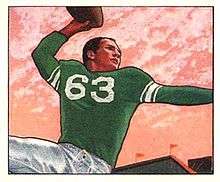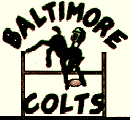Baltimore Colts (1947–50)
.png) | |
| Founded | 1947 |
|---|---|
| Folded | 1950 |
| Based in | Baltimore, Maryland, United States |
| League |
All-America Football Conference (1947–1949) National Football League (1950) |
| Division | National Conference |
| Team history |
Miami Seahawks (1946) (de facto) Baltimore Colts (1947–50) |
| Team colors |
Green, Silver, White |
| Head coaches |
Cecil Isbell (1947–49) Walter Driskill (1949) Clem Crowe (1950) |
| Owner(s) | Abraham Watner (1947–50) |
| Mascot(s) |
horse (with football helmet) jumping over goal posts, horseshoe on helmet |
| Home field(s) |
Municipal Stadium (1947-1949), Memorial Stadium (1950) |
The Baltimore Colts were a professional American football team based in Baltimore, Maryland. The first team to bear the name Baltimore Colts, they were members of the All-America Football Conference (AAFC) from 1947 to 1949 and then joined the National Football League (NFL) for one season before folding. They were one of the least successful teams in the AAFC and NFL both on and off the field, winning only 11 games in their history. In 1953, Baltimore was granted an expansion team that revived the Colts name; this team is now the Indianapolis Colts.
The Colts' origin is with the Miami Seahawks, one of the charter franchises of the AAFC. After playing a single disastrous season the Seahawks were confiscated by the league, and were purchased and reorganized by a group of businessmen as the Baltimore Colts. The new team struggled through the next three seasons, but managed to grow a sizable fan base in Baltimore. In 1949 the Colts were one of three AAFC teams, along with the San Francisco 49ers and the Cleveland Browns, to be brought into the NFL following the AAFC-NFL merger. They played only during the 1950 season before financial pressures forced them to fold.
History

The All-America Football Conference had initially intended to place a team in Baltimore in its opening 1946 season, but its prospective owner, retired boxer Gene Tunney, was unable to secure a stadium deal.[1] Needing an eighth team to balance the schedule, AAFC officials granted a franchise to a group of Miami-based boosters, and the Miami Seahawks were born.[2]
From the first, the Seahawks were beset with problems. They were a weak team with a difficult schedule in by far the smallest market in the league. They drew little fan support and accumulated debts of up to $350,000, which owner Harvey Hester could not afford to repay. League commissioner Jim Crowley expropriated the franchise, and the AAFC covered its overdue travel and payroll costs.[3]
Five businessmen, led by Washington, D.C. attorney Robert D. Rodenburg, made a bid to purchase the Seahawks' assets and use them to start a new team in Baltimore.[3] The AAFC quickly approved the deal, and the team was reorganized as the Baltimore Colts, a name chosen due to the city's long history of horse racing and breeding. Due to the club's inherited talent drought, the Colts were permitted to recruit a player from each of the AAFC's four strongest teams.[3] Nevertheless, the Colts struggled financially through the 1947 season, leading the owners to walk away after the season. The team was little better on the field, winning only two games to finish in the Eastern Division basement.[4] Sensing a crisis, the AAFC supplied the its three weakest teams--the Colts, the Chicago Rockets and the Brooklyn Dodgers--with superior players. The team found new ownership, but its financial crisis was not resolved. Even with stronger players, the Colts were still barely competitive on the field in 1948. However, the Eastern Division was extremely weak that year; none of its four teams tallied a winning record. The Colts tied for first with the Buffalo Bills with a 7–7 record, and lost the division championship game to the Bills.[5] The team regressed in 1949, finishing dead last with a 1-11 record.
In 1948 both the AAFC and the NFL were struggling, and determined that the continued viability of professional football depended on a merger between the leagues. The leagues began negotiating a deal in which three AAFC teams would be brought into the NFL and the owners of others would be compensated for their interest. The Cleveland Browns and San Francisco 49ers, clearly the AAFC's strongest teams, were obvious choices. It initially appeared that the Bills would be the third team in the merger. However, the Colts' owners pressed to be included in the Bills' place even though they were one of the weakest teams in the league both on and off the field. George Preston Marshall, owner of the Washington Redskins, initially refused to cooperate. He considered Baltimore to be part of his home territory, and believed the Colts would infringe on his rights. Marshall finally relented in exchange for the Colts paying him $150,000 for the infringement. With this obstacle overcome, the merger was finalized, and the Colts were brought into the NFL.[6]
The Bills were arguably a better choice for entry into the NFL; they were in a more isolated market, had stronger attendance and performed better on the field. The newly merged league's owners actually scheduled a second vote to add the Bills in order to balance the schedule. However, in those days, adding a new team required a unanimous vote, and the Chicago Bears's George Halas and the Los Angeles Rams' Dan Reeves persuaded two other clubs to vote with them in blocking the merger. (The Bills were not the same as the modern Buffalo Bills franchise, which joined the NFL in 1970.)
The Colts were nominally part of the "National Conference" along with the other eastern teams in the merged league. However, unlike the other twelve teams, Baltimore was scheduled as a "swing team" and played every team in the NFL over the course of the 1950 season (whereas the other twelve teams played a double round robin schedule in their conference plus one crossover game with the opposing conference and a game with Baltimore).
Despite the addition of the Bills players, the Colts struggled through the 1950 season, ending with a record of 1–11–0. Facing a financial crisis, Colts owner Abraham Watner sold the team and its player contracts back to the NFL for $50,000, and the team officially folded. Still, however, fan support continued in many quarters; notably, the team's marching band and fan club remained intact after the team folded. Three years later another franchise, also named the Baltimore Colts, came to Baltimore. This team relocated to Indianapolis in 1984, and was renamed the Indianapolis Colts. The supporting groups, including the fan club and marching band remained, however, again working to revive a team in Baltimore. In 1996, the Baltimore Ravens were formed from the players and staff of the Cleveland Browns. The marching band (now known as Baltimore's Marching Ravens) and fan club became affiliated with the Ravens. The Baltimore Colts name was briefly revived in 1994 when the Canadian Football League created a Baltimore-based expansion team of that name; however, following a lawsuit from the NFL the name was changed to the Baltimore Stallions.
First round draft picks
AAFC
- 1947 Elmer Madar End Michigan
- 1948 Bobby Layne QB Texas
- 1949 George Sims Back Baylor
NFL
- 1950 Adrian Burk QB Baylor
Pro Football Hall of Famers
- George Blanda (1950—played only one game for Baltimore)
- Art Donovan
- Y.A. Tittle
Season-by-season
| Season | W | L | T | Finish | Playoff results | |
|---|---|---|---|---|---|---|
| Baltimore Colts | ||||||
| 1947 | 2 | 11 | 1 | 4th AAFC East | – | |
 |
1948 | 7 | 7 | 0 | 2nd AAFC East | Lost Eastern Division Championship Buffalo 28, Baltimore 17 |
| 1949 | 1 | 11 | 0 | 7th AAFC | – | |
| Merged into NFL | ||||||
| 1950 | 1 | 11 | 0 | 7th National | – | |
| Totals | 11 | 40 | 1 | |||
Notes
References
- Coenen, Craig R. (2005). From Sandlots to the Super Bowl: the National Football League, 1920–1967. University of Tennessee Press. ISBN 1-57233-447-9. Retrieved October 1, 2010.
